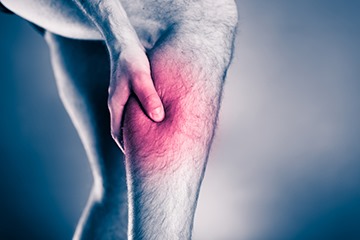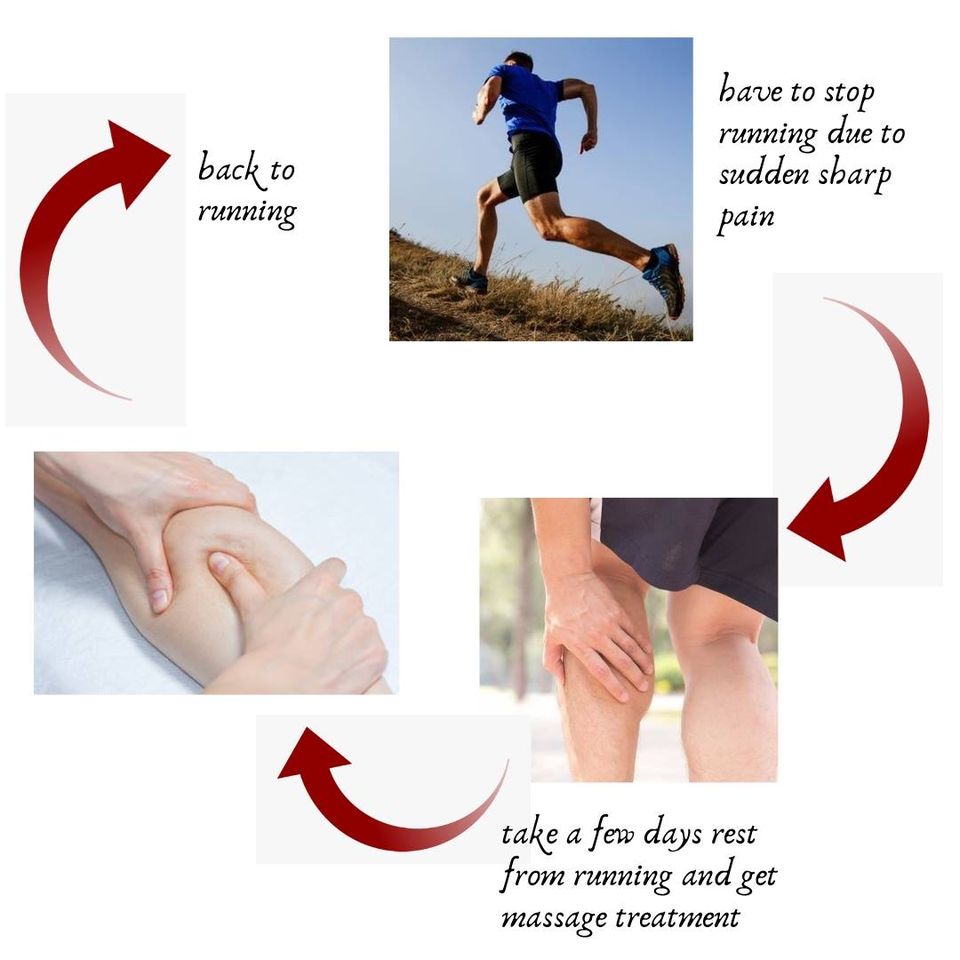CALF HEART ATTACKS IN RUNNERS & TRI-ATHLETES

Have you ever been out running and experienced some mild tension in your calf, which then rapidly turns into a sharp tearing pain, which forces you to stop running? Sometimes a runner will experience micro-tears in the calf, maybe think they have a mildly strained muscle, but then end up in a negative cycle, where the injury gets worse each time. Maybe after a few days of massage and rest, the calf appears to have recovered, so running resumes, but after perhaps a couple of miles the pain returns and it’s another few days out of action. The cycle continues. You could be experiencing a calf heart attack.
 The main bulk of the calf is made up of the superficial gastrocnemius, and the deeper soleus muscles, and they act as shock absorbers upon landing and help propel you forward. If overloaded, the muscle fibres of the calf suffer micro tears which alter the spring mechanism, causing pain, inflammation, and put a stop to your running. Once healing starts we think it is ok to return to running, but it actually requires a longer period of time, so reinjury occurs. Also by not gradually progressing after the rest period, we also increase the risk of reinjury.
The main bulk of the calf is made up of the superficial gastrocnemius, and the deeper soleus muscles, and they act as shock absorbers upon landing and help propel you forward. If overloaded, the muscle fibres of the calf suffer micro tears which alter the spring mechanism, causing pain, inflammation, and put a stop to your running. Once healing starts we think it is ok to return to running, but it actually requires a longer period of time, so reinjury occurs. Also by not gradually progressing after the rest period, we also increase the risk of reinjury.
CAUSES & RISK FACTORS
• Chronic exertional compartment syndrome, when the muscle swells during exercise, the surrounding sheath isn't flexible enough, so can’t accommodate the increased blood flow. The muscle is constricted, some fibres tear, creating scar tissue often remains, which increases risk of reinjury, thus the cyclical nature of this problem. (see posts on CECS) -
• middle-aged men with mechanical faults in their running technique leading to moderate to severe muscle tension
• gait problems :-
- EXCESSIVE TOE-OUT - calf tightness limits the ankle from bending during toe-off, resulting in a lateral toe-out pattern, causing the calf to be loaded unevenly
- EXCESSIVE ANTERIOR PELVIC TILT- tight iliopsoas or hip flexors may pull the pelvis forward and limit gluteal activation while running. The calf then has to work harder and becomes stressed
- OVER-REACHING STRIDE - a longer stride means more time spent on the ground and increased load on the calf, reducing the spring mechanism and propulsion (see previous post on running technique)
• Men are 75% more prone to Achilles injuries than women as they are generally are less elongated than women’s during dorsiflexion (when the toes lift up toward the shin). The additional strain that this places on the tendon may be linked to calf heart attacks since the Achilles is an integral component of the spring mechanism.
TREATMENT
5-7 DAYS FOLLOWING INJURY - before you resume running.
• REST - Do not run for at least a week, even if it feels better as the calf will have to work hard and you risk re-injury. Daily walking, cycling or swimming to improve circulation to the injured area IF they don’t cause pain. If ,pain starts up, stop immediately and try again after 2 or 3 days. Once you can do these low impact exercises for one week without pain, you can then try to run.
• MASSAGE – including self-massage – The Stick massage tool can work deeper when ice packs aren’t effective, but should be used lightly for 5 minutes twice a day, just to reduce spasms. Do NOT stretch your calf until healed
• ICE PACKS – 10 minutes twice a day for the first couple of days, may help relieve pain and inflammation, depending on the depth of the injury
• COMPRESSION – some find compression stockings helpful in the early stages of healing to assist with blood circulation
2nd WEEK
• After no running for the first week, the aim is to encourage circulation further without re-injury. Start by walking a mile on a flat surface, then jog for a few hundred yards. Continue to alternate between walking and jogging for 3-4 miles. If the calf begins to feel numb or sore, stop immediately. Your goal is to get as much circulation to it as possible without re-injuring it.
• Take day 2 off as the calf still won’t be completely healed, and then repeat the procedure on day 3, continuing to alternate for a week; increasing the jogging distance as the calf becomes stronger
3rd WEEK Go for a very gentle run of 3-4 miles, or 25% of what is a short run for you, on a flat surface, stopping immediately if pain or numbness appears. Gradually increase distance and intensity every 3 days, by no more than 10%, retreating to the previous stage if symptoms reappear.
PREVENTION
• TEST & MAINTAIN FLEXIBILITY - kneel on one knee and place the toes of the front leg against a table leg. Keep your foot straight and arch off the ground. Shift your body forward until your knee touches the table leg. If it doesn’t touch, move your foot closer. If your knee easily touches, move your foot away. Repeat this until you’re unable to go farther back without your knee touching and foot remaining straight. Measure the distance from your first toe to the table leg. This should be at least three inches. Measures less than this could cause mechanical problems with your running gait to strain your calf.
• ANKLE MOBILITY & STRETCHING the calves and Achilles tendons for at least 5 minutes every day, particularly if you can’t achieve 3” on the test above. Calf stretching can be incorporated into basic activities such as working on the computer or talking on the phone.
• SOFT TISSUE RESTRICTIONS - use TheStick massager for 3-5 minutes a day, to minimise any scar tissue and maintain flexibility in the muscle and sheath of the calf, using firm pressure, particularly after sitting for long periods or when increasing mileage or intensity.
• WARMING UP PROPERLY – warming up the soft tissues for 5-10 minutes, particularly when going for a run in the cold, or early morning, or after a long day at work, improves the spring mechanism of the calf and reduces the stress from running.
• TRAINING PARAMETERS (distance, surface, intensity, speed, frequency) – making changes to training should be gradual, no more than 10% increase and only involve changes to one parameter at a time, to avoid overloading the muscles.
• FOOTWEAR – supportive footwear when running is essential, if you’ve had repeated calf heart attacks in the same style shoe you may want to consider changing. New shoes will always feel different so transition into them slowly. Even your everyday shoes may alter your posture and running mechanics. Even a half-inch heel can lead to reduced calf and Achilles flexibility.
• RUNNING MECHANICS - a sports therapist who specializes in running gait can assess whether your flexibility, strength, footwear, and overall movement patterns are negatively impacting on your running mechanics, as well as offering soft tissue mobilisation.
• STRENGTHENING EXERCISES- calf and glute strengthening is essential if running is your only athletic activity, to strengthen the calf and other push-off muscles, and to avoid overloading the calf.
- SINGLE LEG CALF RAISE - on the edge of a step, exaggerating a slow lowering phase
- GLUTE BRIDGE - maintain a neutral core by tucking in your tail bone, holding your core tight, and squeezing your glutes as you lift your hips up. For more of a challenge, perform on one leg at a time.
- SINGLE LEG DEADLIFT – engages the muscles of the foot and lower leg while focusing on balance. As you resume a standing position, pay attention to squeezing your glute on the leg that’s on the ground. Adding resistance to your hand opposite the leg on the ground will increase the challenge.
